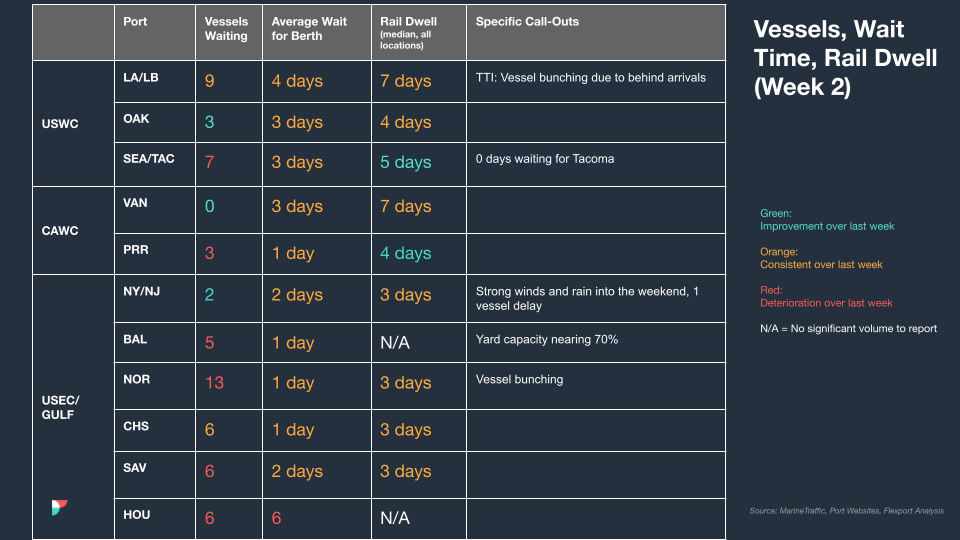Trends to Watch
- [TAWB – Ocean] Market demand has remained relatively stable in January with no spikes expected until March at the earliest. While the total vessel filling factor is still not at 100%, it has slightly increased as a direct result of the winter blank sailing program and some carrier capacity cuts. Overall capacity remains high despite an anticipated 20% decrease on average for January and February due to blank sailings. We expect carriers to pull more capacity in the coming weeks to help with the Red Sea situation. We’ve already seen members of the Ocean Alliance and 2M (Maersk and MSC) doing this. As a direct impact of the Red Sea situation, rates for vessels traveling on Transatlantic routes have started to increase, and are expected to increase further in February when most carriers announce GRI/PSS and emergency surcharges. In other news, equipment shortages have started to impact Austria and some areas of South Germany as reported by a few shipping lines. The full impact is likely to be seen at later stages and will also depend on the outcome of the current German railway situation.
- [FEWB – Ocean] Asia-North Europe: Market demand is moving up for the second half of January and all ships are filling up, will roll pool by carriers in progress for the coming weeks. Week 3 spot rates slightly increased due to the Lunar New Year rush and week 4 spot rates are stabilizing at high pre-Lunar New Year levels. As the Red Sea crisis continues, it’s now estimated for a vessel to take 2-4 weeks (round trip) depending on the destination. As a direct impact, Ocean Alliance and 2M announced 15+ void plans for February with more to be expected from THE Alliance soon. Equipment shortages can be expected in the coming weeks if the situation remains the same. German Strike: The strike ended on January 12 but no agreement was reached. We expect there will be another round of strikes as a result. No immediate impact is expected. Gemini Cooperation: Maersk and Hapag Lloyd announced an official cooperation agreement that will start in January 2025. More to follow on the actions of additional carriers.
- [MED Trade] Following North Europe, MED spot rates for the second half of January are increasing in week 3. Week 4 spot rates are expected to be slightly lower as carriers are pushing cargo to fill up ships before the Lunar New Year.
- [U.S. Exports] As the Red Sea situation continues, U.S. exporters shipping globally can expect equipment shortages due to mislocated containers. We highly recommend booking shipments 4+ weeks in advance to ensure Expected Quantity (EQ) can be secured.
- [Air – Global] The first week of 2024 saw a continued decline in worldwide air cargo tonnages, following a typical slump in the latter half of December. Preliminary data for week one shows a 6% week-over-week drop in global air cargo tonnages, with significant declines noted particularly in shipments from the Asia Pacific to North America and the Middle East & South Asia, and within the Asia Pacific region. This year’s decline in tonnages during the first week contrasts with the stability observed in the same period of 2023, potentially influenced by the inclusion of January 1, a holiday, in this year’s week one calculation. On a two-week comparison basis, the total tonnage for the last two weeks of 2023 and the first week of 2024 was down 28%, with average rates dropping by 5% and capacity decreasing by 8%. Despite these declines, global tonnages for the same period were around 3% higher year-over-year, with worldwide average rates currently 19% below last year’s levels but still 30% above pre-COVID levels, according to World ACD.
North America Vessel Dwell Times

This Week In News
Container Shortage Starts To Bite, Adding to Pressure on Costs
Global container shortages are causing disruptions in shipping, particularly in the Red Sea region, leading to re-routings, delays, and cancellations. Despite earlier predictions, the industry is feeling the impact, with difficulties in obtaining 40ft high-cube and 20ft General Purpose containers in major Chinese ports. Forwarders are reporting similar issues, with concerns about higher costs arising from these shortages, especially in China, indicating potential turbulent times in 2024 for the outbound leg from Asia to Europe.
Shifts in Chinese Exports Show Ties With U.S. Economy Fraying
In a notable shift, China exported more goods to Southeast Asia than to the United States last year, indicating a change in global trade patterns amid strained economic relations. Data from China’s General Administration of Customs reveals that the 10 ASEAN nations purchased $524 billion of goods, surpassing the $500 billion sold to the US. While this suggests a gradual separation between China and the U.S., the situation is complex. Chinese exports to Mexico increased by over 5%, potentially to avoid U.S. tariffs. Exports to Thailand and Vietnam also declined less than in other regions, reflecting the trend of shipping goods there for finishing and re-export.
Port Houston Cargo Volumes Dip 15% YoY in November
In November, Port Houston experienced a 15% year-over-year decline in cargo volumes to 297,622 total TEUs, although empties decreased by 34%. Compared to the previous month, cargo processing dropped by 19%, but there was a 21% increase in total containers processed compared to pre-pandemic levels. Despite these changes, Port Houston welcomed the CMA CGM Lisa Marie, one of its largest vessels with a capacity of nearly 11,000 TEUs. The port is strategically planning for growth, expanding the Houston Ship Channel to accommodate larger vessels and increasing wharf and yard capacity at container terminals to support regional growth.
Source from Flexport.com
